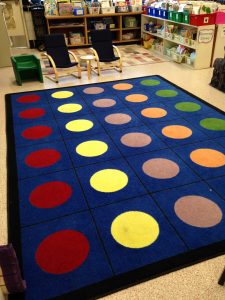As I explore the differences between districts that have and have not, I’d like to point out an elementary school rug from the land of plenty. 
Now a rug from the land of around 90% free and reduced lunches:
 This is not the actual rug. The actual rug does not look this clean. If I get back to that classroom, I’ll take a picture of that tatty, plain, gray rug.
This is not the actual rug. The actual rug does not look this clean. If I get back to that classroom, I’ll take a picture of that tatty, plain, gray rug.
I don’t know why I did not think to snap a picture of that rug, because as soon as I saw it I went straight to the problem: How do the kids know where to sit? People who have never taught will probably think that we can simply assign them places. But even with neat little circles and squares, kindergarteners, first graders, and even older elementary school children struggle with seating order and their places. They elbow each other. They tattle when elbowed and tattle for other reasons, great and small. “Anthony’s in Mayra’s spot!” “Anthony’s leg’s touching me!” “She’s sitting over the line.” “He’s sneaking into my spot!”
Those squares and circles provide clear boundaries. They allow for easy control. “Criss-cross, applesauce, please get your legs inside the lines, Anthony,” I can say. Mostly, that request will solve my problem.
In contrast, that gray rug looks like a free-for-all waiting to happen. The color would not appeal to young children if that rug were clean and spotless. Plain gray rugs do not beckon children into cozy reading experiences.
Eduhonesty: If you were six, which rug would you choose? I am sure the gray rug cost far less money. But those squares and dots make classroom management much easier and save so much learning time that I’d like to suggest districts pay up for the better rug.
I point out these rugs as one more tiny, yet real, reason for the academic achievement gap between our wealthier and financially-challenged districts.
